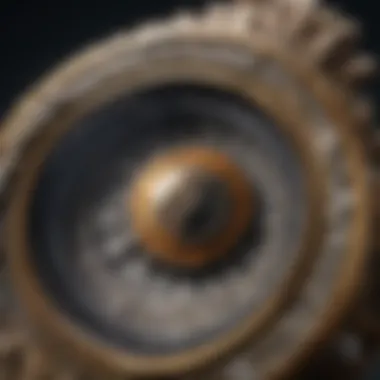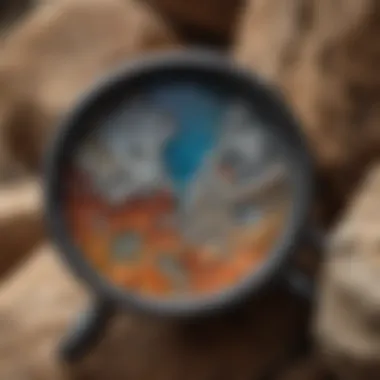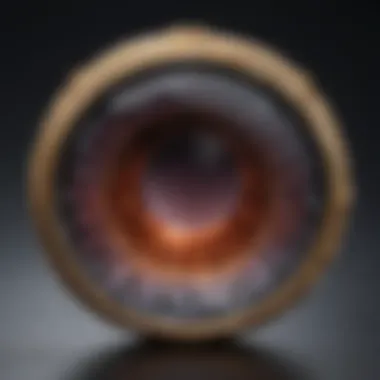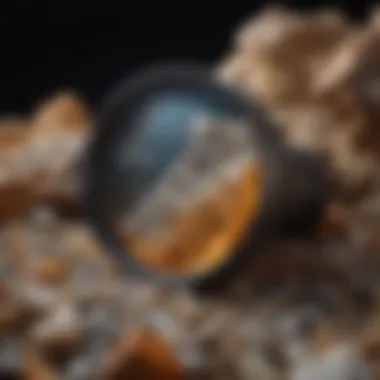Unveiling the Fascinating World of Jeweler's Loupes: A Comprehensive Guide for Geological Enthusiasts


Rock and Fossil Identification
Jeweler's loupes open up a fascinating realm of exploration for geological enthusiasts keen on unraveling the intricate details of rocks, fossils, and geological specimens. As you peer through the lens of a jeweler's loupe, the world of geology unfolds before your eyes with remarkable precision. Understanding the key characteristics of rocks and fossils is essential for accurate identification. Different types of rocks, ranging from igneous to sedimentary and metamorphic, each possess unique traits that provide valuable clues to their formation and composition. Fossils, on the other hand, offer a glimpse into prehistoric life based on their preservation and structure. To effectively identify rocks and fossils, collectors need to pay attention to specific features such as mineral composition, texture, color, and any visible imprints or fossils embedded within the specimens. Equipping yourself with the right tools, including loupes with varying magnification levels, ensures a closer look at these geological treasures for a more detailed analysis of their intricacies. A meticulous approach to rock and fossil identification is fundamental to enhancing your geological pursuits.
Collecting Tips and Techniques
Embarking on a rock and fossil collection journey requires a blend of passion, patience, and precision. To excel in this pursuit, understanding best practices for collecting is paramount. Whether you are exploring a local terrain or venturing into remote landscapes, knowing how to spot prime collecting sites can significantly enhance your chances of discovering unique specimens. Safely extracting rocks and fossils from their natural habitat demands caution and adherence to ethical collection practices to preserve the integrity of the environment and the specimens. Implementing gentle extraction techniques using specialized tools ensures minimal damage to the specimens, allowing for a more extensive collection without jeopardizing the surrounding ecosystem. By honing your collecting skills and techniques, you can enrich your geological collection with rare and well-preserved specimens, elevating the quality and diversity of your discoveries.
Preservation and Display
Once you have amassed a collection of rocks and fossils, the next crucial step is their preservation and display. Proper preservation techniques are essential to maintain the integrity and longevity of your specimens. Implementing methods such as gentle cleaning, drying, and storing in suitable containers or display cases protects rocks and fossils from deterioration and external influences. Selecting appropriate storage methods, such as acid-free paper for delicate specimens and a controlled environment for temperature and humidity regulation, ensures their preservation for future generations to appreciate. Exploring creative display ideas allows you to showcase your geological treasures in an aesthetically pleasing and informative manner, offering insights into their uniqueness and significance within the field of geology.
Geological Insights
Delving deeper into the geological realm unveils a vast array of formations, processes, and historical narratives encapsulated within rocks and fossils. Understanding the geological formations and processes that shape the Earth's surface provides valuable insights into the evolution of landscapes over millions of years. Rocks and fossils serve as historical archives, documenting the environmental conditions and life forms that existed in different geological eras. Exploring the historical significance of rocks and fossils sheds light on past geological events and evolutionary milestones, enriching our understanding of Earth's dynamic history. Furthermore, recognizing notable discoveries in the field of geology highlights groundbreaking contributions that have revolutionized our knowledge of the Earth's geology and biodiversity. By immersing yourself in these geological insights, you gain a profound appreciation for the profound mysteries and wonders contained within the world of rocks, fossils, and geological treasures.
Intro
In the realm of geological exploration, one tool stands out for its invaluable role in uncovering the intricacies of rocks and minerals – the jeweler's loupe. As we embark on this comprehensive guide tailored for the discerning geological enthusiasts, we delve into the essence of these optical instruments that open doors to a microscopic world of wonders. The journey begins with unraveling the fundamental principles of jeweler's loupes and gradually progresses into the practical applications that revolutionize geological study. Through this exploration, collectors can elevate their understanding and appreciation of geological formations to unprecedented levels, magnifying the beauty and significance of each specimen with unparalleled clarity and precision.


Defining Jeweler's Loupes
At the core of geological examination lies the fundamental concept of jeweler's loupes. These specialized magnifying instruments, crafted with precision and expertise, serve as the gateways to a hidden realm of minuscule details. Defined by their high-quality lenses and ergonomic designs, jeweler's loupes offer enthusiasts a glimpse into the microscopic features embedded within rocks, minerals, and fossils. By understanding the basic construction and functionality of these loupes, collectors can elevate their observational skills and immerse themselves in a world where the naked eye fails to venture.
Significance in Geological Exploration
The significance of jeweler's loupes in geological exploration cannot be overstated. These optical aids play a pivotal role in unraveling the mysteries concealed within geological specimens, allowing collectors to unearth hidden details and anomalies that evade casual observation. By magnifying textures, colors, and structures, jeweler's loupes enable enthusiasts to conduct in-depth analyses, identify mineral compositions, and distinguish subtle variations that define the uniqueness of each specimen. Through the lens of a loupe, geological exploration transcends surface-level observations, paving the way for a deeper comprehension of the Earth's rich tapestry of minerals and rocks.
Understanding Loupe Specifications
In the realm of geological exploration, understanding loupe specifications is a fundamental aspect that demands meticulous attention. Jewelers' loupes, with their unparalleled precision, serve as indispensable tools for scrutinizing the intricate details of rocks, fossils, and geological specimens. Delving into the specifics of loupe specifications not only enriches the collector's experience but also unveils a world of hidden wonders waiting to be discovered.
Magnification Levels
One of the primary considerations when delving into loupe specifications is the magnification levels they offer. The ability to zoom in on minute details with clarity and precision is a quintessential feature for geological enthusiasts. Loupes with varying magnification levels enable collectors to explore geological specimens with different levels of depth and intricacy. Understanding the optimal magnification required for specific specimens is crucial in unraveling their hidden secrets and nuances.
Lens Types and Quality
Another pivotal aspect of loupe specifications is the diversity in lens types and their quality. From achromatic to plano-convex lenses, each lens type offers a unique perspective and clarity in viewing geological specimens. The quality of the lens plays a crucial role in enhancing the sharpness and crispness of the image, allowing collectors to discern even the tiniest of details. Choosing a loupe with superior lens quality ensures a more immersive and rewarding exploration of geological treasures.
Choosing the Right Loupe


Selecting the right loupe is a critical decision for rock and fossil collectors aiming to delve into minute geological details efficiently. The choice of loupe can significantly impact the clarity and precision of observations, making it crucial to consider specific elements when making this selection. Opting for the appropriate loupe enhances the collector's ability to scrutinize specimens intricately, unlocking hidden features and textures otherwise overlooked with the naked eye.
Factors to Consider
When choosing a loupe, various factors come into play to ensure an optimal selection aligning with the collector's needs and preferences. Factors such as magnification power, lens quality, light source compatibility, and portability should be meticulously evaluated. Magnification power plays a pivotal role in enabling close examination of specimens, with variations ranging from 10x to 30x or higher. Lens quality dictates the sharpness and clarity of observed details, making it imperative to opt for high-quality lenses to preserve the integrity of geological features. Moreover, considering factors like LED or UV light compatibility for illumination, and the loupe's size and weight for convenience during fieldwork are crucial aspects that warrant attention.
Popular Brands and Models
Diving into the realm of loupe selection unveils a plethora of popular brands and models renowned for their exceptional quality and performance. Brands like BelOMO, Eschenbach, and SE provide a diverse range of loupes tailored to different collector requirements. Models such as BelOMO 10x Triplet Loupe, Eschenbach Mobilux LED Illuminated Magnifier, and SE Deluxe Dual Lens Loupe stand out for their reliable magnification capabilities and durable construction. Exploring these popular brands and models allows collectors to make informed decisions based on reviews, specifications, and reputation within the geological community.
Practical Applications of Jeweler's Loupes
In the realm of geological exploration, the practical applications of jeweler's loupes are invaluable. These precision tools serve as windows into a hidden world, allowing enthusiasts to explore the intricate details of rocks, fossils, and other geological specimens with unparalleled clarity. By magnifying the minuscule features of geologic samples, loupes enable collectors to scrutinize textures, colors, and structures that are otherwise invisible to the naked eye. This close examination is crucial for identifying key characteristics, assessing quality, and gaining deeper insights into the geological composition of specimens.
The foremost benefit of using jeweler's loupes for examining geologic specimens lies in their ability to reveal the subtle nuances and hidden secrets of rocks and fossils. Whether observing the crystalline structure of minerals, the stratification of sedimentary layers, or the random>intimation perfectionrandom> of a fossilized imprint, loupes provide a level of detail that is indispensable for geological enthusiasts. Moreover, these tools enhance the overall viewing experience by bringing forth aspects of specimens that might otherwise go unnoticed, enriching the appreciation of geological diversity and complexity.
Furthermore, practical considerations come into play when utilizing jeweler's loupes for examining geologic specimens. Selecting the appropriate magnification level is crucial, as it determines the extent to which details can be observed and analyzed. Additionally, lighting conditions play a significant role in enhancing visibility and allowing for accurate assessments. By carefully choosing the right loupe and optimizing viewing conditions, collectors can maximize the utility of these tools for their geological explorations.
Maintenance and Care Tips


In the expansive realm of geological exploration, the facet that often garners less limelight but holds profound significance is the maintenance and care of essential tools, including the invaluable jeweler's loupe. While enthusiasts passionately scrutinize rocks and fossils through the lenses of these optical instruments, maintaining them in pristine condition is crucial to ensure precise observations. The longevity and performance of a jeweler's loupe hinge on diligent maintenance practices, which go hand in hand with unlocking the intricate details embedded within geological specimens. By delving into maintenance and care tips, this section aims to underscore the pivotal role that proper upkeep plays in sustaining the functionality and precision of these indispensable tools.
Cleaning Procedures
Among the cardinal aspects of maintaining a jeweler's loupe is adhering to meticulous cleaning procedures. The clarity and accuracy of observations heavily rely on the cleanliness of the lens, free from smudges, dust particles, or any other contaminants that could impede visibility. Optimal cleaning techniques involve using specialized lens cleaning solutions or gentle lens wipes to delicately remove any deposits without risking scratches or damage. Regular cleaning not only enhances the optical clarity of the loupe but also prolongs its lifespan, ensuring continued impeccable performance for thorough examinations of geological specimens.
Storage Recommendations
Equally integral to sustaining the functionality and longevity of a jeweler's loupe are proper storage practices. Offering protection from dust, moisture, or accidental damage, appropriate storage safeguards the delicate optical components from potential harm, thereby preserving the loupe's precision and performance over time. Storing the loupe in a designated case or container, shielded from exposure to environmental elements, helps maintain its pristine condition between uses. Implementing proactive storage recommendations not only safeguards the loupe but also streamlines access for seamless integration into geological exploration endeavors, ensuring efficiency and efficacy in usage.
Enhancing Your Geological Collection Experience
In this comprehensive guide unravelling the world of jeweler's loupes, it is imperative to delve into enhancing your geological collection experience. For rock and fossil enthusiasts, elevating the process of examining and appreciating geological specimens is not only a pastime but a profound exploration of Earth's history through a magnifying glass. The strategic integration of jeweler's loupes into your collection routine opens up a realm of intricate details and hidden features within rocks, minerals, and fossils.
By incorporating the usage of loupes into your regular specimen viewing, you transcend mere observation to a meticulous examination of textures, colors, and formations that are invisible to the naked eye. This heightened level of scrutiny allows for a deeper understanding of geological processes, such as crystallization, metamorphism, and sedimentation, enriching your overall collection experience. Whether you are a novice collector or a seasoned enthusiast, the act of integrating loupe usage brings a new dimension to your geological journey, fostering a deeper connection with the Earth's geological wonders.
Integrating Loupe Usage Into Your Routine
Integrating loupe usage into your routine is a fascinating endeavor that requires thoughtful consideration and practice. When immersing yourself in the world of geological specimens, incorporating a jeweler's loupe can transform your perception of even the most familiar rocks and minerals. Begin by selecting a comfortable and well-lit workspace conducive to loupe-assisted observation. Position your specimen under adequate lighting and align the loupe carefully to focus on specific areas of interest. Take your time in adjusting the magnification level to unveil intricate details that escape the naked eye.
As you integrate loupe usage into your routine, develop a structured approach to observation by documenting your findings, noting peculiar textures, colors, or mineral compositions that capture your attention. Engage in regular practice sessions to refine your observation skills and familiarize yourself with the nuances of using a loupe effectively. Through consistent integration of loupe usage into your specimen examination routine, you will not only enhance your geological collection experience but also cultivate a keen eye for discerning minute details that convey a wealth of scientific information.
Exploring New Perspectives
Exploring new perspectives through the lens of a jeweler's loupe opens up a world of undiscovered beauty and complexity within geological specimens. By adjusting your viewing angle and manipulating the magnification settings, you can reveal intricate crystal structures, fossilized imprints, and mineral inclusions that tell stories millions of years old. This fresh perspective breathes life into seemingly ordinary rocks, unveiling a hidden realm of geological artistry waiting to be explored.
Delve into the microcosm of geological specimens and embrace the unique textures, patterns, and formations that emerge under the scrutinizing gaze of a loupe. Each specimen becomes a captivating tapestry of Earth's history, offering a glimpse into the processes that shaped our planet over millennia. By exploring new perspectives through the lens of a jeweler's loupe, you transcend surface beauty to uncover the intricate complexities that define the geological world, enriching your collection experience with a tapestry of scientific marvels.







